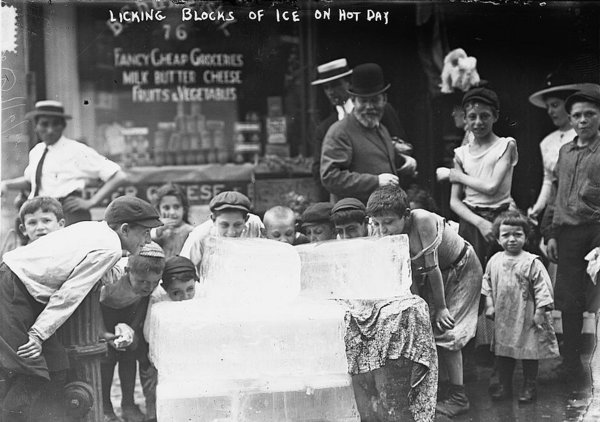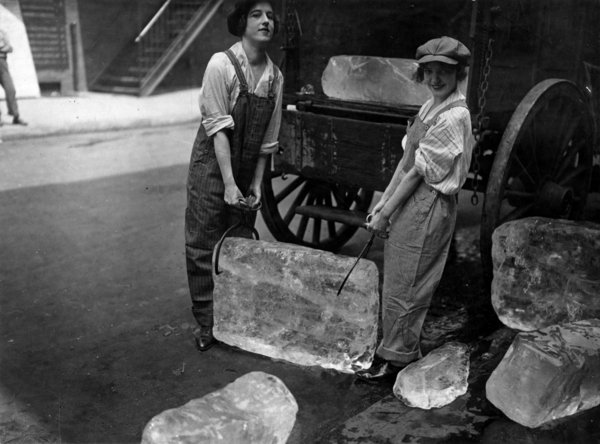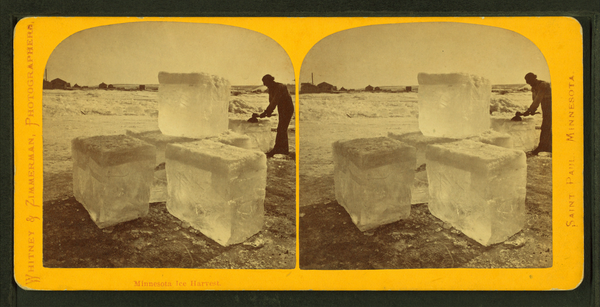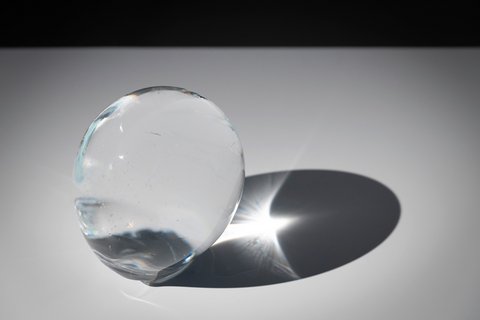
Marijke van Warmerdam, Eiskugel, 1998. Foto: SKD, Oliver Killig.
Marijke van Warmerdam, Eiskugel, 1998. Foto: SKD, Oliver Killig.
Shaped as a perfect sphere, Marijke van Warmerdam’s Eiskugel is at first opaque before it becomes crystal clear. Then, it slowly loses its shape: small cracks and bubbles appear in the material as it glimmers in the light. When do these changes occur? At the first drop of water? What changes are we witnessing? Thoughts of this sort inevitably occur while gazing upon this object. It becomes ever smaller and finally fully disappears from view. The melting water seeps into a box of lacquered wood: we only see a shape that slowly ceases to exist. That the ice ball is completely gone after about two days doesn’t seem to worry us. Water is inexhaustible and ice is perpetual, right?
To be sure, this work is conceived to be perpetual. A certificate that is part of the Schenkung Sammlung Hoffmann states the relevant parameters: Eiskugel consist of a box of lacquered wood measuring 75 x 8 x 100 cm, and a ball of ice of ∅ 25 cm. The ball of ice can be ordered at any ice production company and for its presentation, there is a simple instruction: “Put the ball of ice on the holes in the middle of the box.” This spring, before the work was shown at the Children’s Biennale "Embracing Nature” at the Japanisches Palais, it was already displayed in STILL ALIVE, the first comprehensive presentation of the Schenkung Sammlung Hoffmann at the Albertinum. The work’s entire aesthetic – a circle of loss and repetition – fitted well within the show, which was organized around themes of fluidity, process, vitality, and transience.
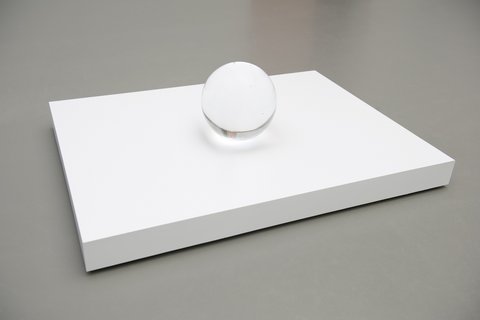
Marijke van Warmerdam, Eiskugel, 1998. Foto: Lotte Stekelenburg, Museum Boijmans van Beuningen, Rotterdam.
Marijke van Warmerdam, Eiskugel, 1998. Foto: Lotte Stekelenburg, Museum Boijmans van Beuningen, Rotterdam.
It is no coincidence that the shape Van Warmerdam chose to let disappear in the gallery space is a sphere – an iconic shape that is an ancient symbol of universal wholeness, as philosopher Lorenz Oken already noted in his Elements of Physiophilosophy (1809/ 1847): “The more spherical a thing is in form, by so much more perfect and divine it is.” One way of interpreting Eiskugel is to see it as a play on thinking about perfection. On the one hand, there is the shape of the object: a sphere, conceived as total and eternal. On the other hand, there is its material: ice, which will inevitably melt once it is placed in a gallery space. You can’t help but notice that after about two days, the ice ball is gone. Of course, it can be replaced by another one. It is, after all, just water that is frozen into a solid state.
Today, it seems often that ice is commonplace – it is something that we can just get whenever we want. While we (rightfully!) worry about melting ice caps and use ice as a metaphor for the disappearance of entire eco-systems, it is also a common ingredient in many cocktails that most of us can just get right from the freezer at home. Sure, we can produce ice, but it is perhaps not something to take for granted.
Roman Emperor Nero (37 – 68) is said to have liked chilled drinks with honey. For the bulk of human history, ice was a true extravaganza: it was hard to get, difficult to store, and expensive. Its creation was only through natural means and cooling technologies relied on cutting ice from rivers, lakes, or getting it from the mountains, and storing it in insolated icehouses or boxes. A key question, especially for those interested in chilling drinks, was how to make ice freeze other substances. Efforts to make new ice succeeded in the mid-sixteenth century, when scientists discovered that if you immerse a sealed bottle of water in a bucket of snow that was mixed with saltpeter, this will freeze the water. Giambattista della Porta for example described this procedure for making chilled wine in his treatise Natural Magick of 1558. Why engage in such a difficult enterprise? “Because of the chief thing desired at feasts, is that Wine cold as ice may be drunk, especially in summer.”
The wine slurpy must have been a great hit at banquets – and one can easily image why. King Henry III of France (1551-1589) is said to have loved his wine chilled and was entranced by anything with ice, displaying heaps of snow and ice sculptures on tables for his guests. The new freezing technique also allowed all sorts of fanciful ice artistry, such as frozen strawberries that were first dipped in water. Then too people knew how to have a good feast, adding ice to every drink they could imagine.
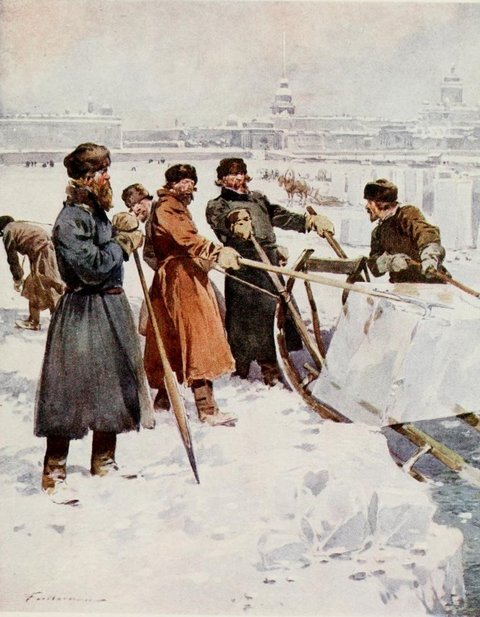
Frédéric de Haenen, Eisschneiden auf der Newa, ca. 1913.
© Wikimedia Commons / Public Domain.
It was only in the nineteenth century, when some significant breakthroughs in refrigeration occurred, that ice became more accessible. America was the first to commercialize the selling of ice. In 1803 a farmer called Thomas Moore created an “ice box”, which he used to transport his butter to marked, and called it a refrigeratory. Frederic Tudor is also a particularly prominent name in the history of the cooling business. Growing up in Boston, Massachusetts, he saw profit in frozen ponds: he had the idea to harvest the ice and to sell it to the colonists sweating in the tropics. Taking this idea seriously, he introduced the world to cold drinks on hot summer days and awakened a thirst in people they did not know they had.
This miniature history is but a little reminder that it actually took us hundreds of years and a lot of ingenuity to have broad access to ice. And even though ice blocks do not have to be dragged from frozen lakes anymore, it still takes a considerable amount of effort to create them. In fact, it took an ice manufacturer from Strausberg (near Berlin) about two weeks to produce a batch of blocks of clear ice large enough for thirty of Van Warmerdam’s ice balls for the exhibition STILL ALIVE and the conditions in which these arrived and were stored in the museum were complex. By now, these ice balls are long gone and have already been replaced by new ones made for the “Children’s Biennale – Embracing nature”, where Eiskugel is currently on display.
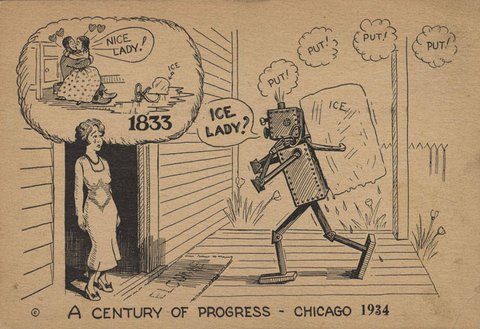
Nice Lady ! Ice Lady ? A Century Of Progress - Chicago 1934. Aus der Grant Schmalgemeier Century of Progress Collection. Foto: Wikimedia Commons.
Nice Lady ! Ice Lady ? A Century Of Progress - Chicago 1934. Aus der Grant Schmalgemeier Century of Progress Collection. Foto: Wikimedia Commons.
Like cool drinks in the summer, art is something that we desire – need, even – and we’ll go great lengths to get it. Looking at Eiskugel in the gallery spaces of the Albertinum and the Japanisches Palais, the process behind its creation is not directly visible: instead, we see a fascinatingly perfect object that slowly melts right in front of us.
